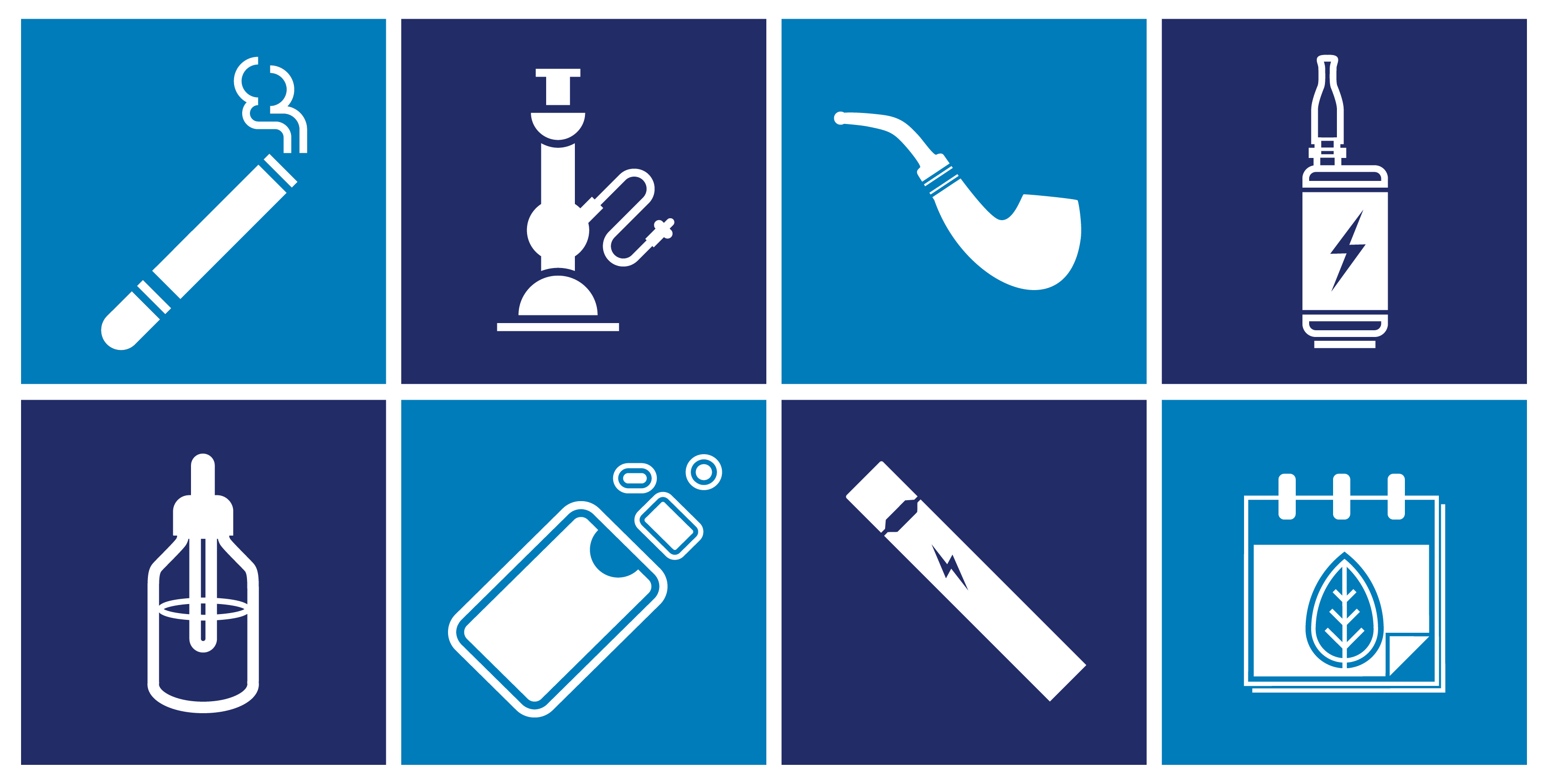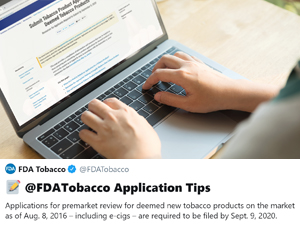Perspective: FDA’s Preparations for the September 9 Submission Deadline
By Mitch Zeller, Director of the FDA’s Center for Tobacco Products (CTP)
August 31, 2020
On Sept. 9, premarket review applications for many new tobacco products, including e-cigarettes, certain cigars, and hookah products, currently on the market are due to FDA for review. FDA staff have been working tirelessly on preparations to meet this challenge in an efficient, reliable and transparent manner.
The Deeming Rule and FDA’s Premarket Review Requirement for Deemed Tobacco Products
Prior to Aug. 8, 2016, e-cigarettes, cigars and hookah products were not regulated by FDA. That’s because the original grant of authority from Congress in 2009 only covered cigarettes, smokeless tobacco, cigarette tobacco, and roll-your-own tobacco.
That all changed with FDA’s historic “Deeming Rule” that helps implement the Tobacco Control Act and allows FDA to protect the public health and protect future generations from the dangers of tobacco use. On Aug. 8, 2016, when the deeming rule took effect, many of the regulatory and statutory requirements that had been in place for manufacturers of cigarettes, smokeless tobacco, cigarette tobacco, and roll-your-own tobacco since 2009, became applicable to e-cigarettes and all other electronic nicotine delivery systems (ENDS), cigars, pipe tobacco, nicotine gels, hookah tobacco, and any future tobacco products.
Before the deeming rule, there were no federal protections on, among other things, retailers selling these tobacco products to youth. The deeming rule changed that and its continued implementation has allowed FDA to make great strides in protecting public health through tobacco regulation—for example, manufacturers of these tobacco products must register their establishments and list their products with FDA, products may not be marketed with direct or indirect claims of reduced risk unless substantiated by FDA and they receive FDA authorization to do so, and retailers are prohibited from selling these tobacco products to youth.
Importantly deemed tobacco products are now subject to the requirements in the Tobacco Control Act that already apply to cigarettes and smokeless tobacco products. This includes the requirement that a “new tobacco product” must receive premarket authorization from the FDA prior to marketing.
For deemed products that met the definition of a new tobacco product and were on the market as of Aug. 8, 2016 (when the deeming rule took effect), FDA issued a compliance policy; this, in effect, provided more time for manufacturers of these products to submit their applications for authorization. The deadline for the submission of applications for these products is now approaching. As the result of a court order (and a subsequent extension due to the unique circumstances of the COVID-19 pandemic), applications for deemed new tobacco products on the market at that time are due to FDA by Sept. 9, 2020 1. The court order also provided a one-year period during which products with timely filed applications might remain on the market pending FDA review.
Since the deeming rule took effect, FDA has been taking measures to prepare for the large volume of applications the agency anticipates receiving, particularly from manufacturers of e-liquids, e-cigarettes and other ENDS products.
Expectations for Applications Coming in by Sept. 9
All new tobacco products are required to obtain premarket authorization through one of three pathways: Premarket Tobacco Product Applications (PMTA), Substantial Equivalence (SE) Reports, or Requests for Exemption from Demonstrating Substantial Equivalence (EX REQ). Those deemed new tobacco products still on the market that do not have premarket applications submitted by Sept. 9, 2020, will be subject to FDA compliance and enforcement actions.
However, there may be some deemed tobacco products that are eligible for “grandfathered status” because they were commercially marketed in the United States as of Feb. 15, 2007. These deemed tobacco products are not “new tobacco products” and therefore do not need to submit premarket applications (unless the products were since modified). We expect that many cigar, hookah tobacco, and pipe tobacco products may fall in this category, and we encourage manufacturers to request a determination from FDA on their products’ grandfathered status. For deemed tobacco products that are not eligible for grandfathered status, manufacturers may decide that their product is sufficiently similar to a previously authorized or grandfathered product and find that the SE or EX REQ pathway is the most appropriate pathway for their applications.
To date, no ENDS product has received marketing authorization from the FDA and FDA has not issued a grandfathered status determination for an ENDS product. All premarket applications for ENDS products accepted by the FDA have been submitted through the PMTA pathway, and we expect most applications for ENDS products submitted on or before Sept. 9 to be submitted through the PMTA pathway.
Although we do not know how many applications will be submitted by the September deadline, we do know that there are over 400 million deemed products listed with FDA. Even if applications are submitted for only a portion of those products, the likelihood of FDA reviewing all of these applications during the one-year review period is low, given that this would be an unprecedented number of applications and several orders of magnitude greater than anything the Agency has experienced. However, FDA has been planning and preparing to receive the expected influx of applications for years. Our preparations are intended to help ensure that our approach to product review protects public health and is fair, consistent, efficient, and as transparent as possible.
We have been encouraging companies to submit their applications as early as possible. To date, FDA has received applications for around 2,000 deemed products – of which around 40 percent have already been resolved.
Preparations to Receive Premarket Review Applications
FDA has been working tirelessly to ensure that we are as prepared as possible to receive, process, and review the applications in a timely manner. To help accomplish this, we have been laying the groundwork for many years.
Since Congress authorized FDA to regulate tobacco products in 2009, CTP’s staff has increased from just a handful to over 950 today. During that time, we have built product review expertise and refined our premarket review processes, enhanced our technical capabilities, issued rules and guidances, met with stakeholders to get a better understanding of tobacco products and applicants’ needs for information about the process, invested in tobacco product research, and provided resources to help industry prepare and submit premarket applications.
BUILDING EXPERTISE AND REFINING THE PREMARKET REVIEW PROCESSES
Although the applications received in response to the Sept. 9 deadline will generally be for deemed products, FDA has been successfully conducting premarket review of cigarettes, smokeless tobacco and roll-your-own tobacco for many years. Since 2009, we have received over 600 PMTAs, more than 7,700 SE Reports and over 800 EX REQs—and have closed out a large majority of these applications. Shaped by the experiences, challenges and lessons learned over the last decade, we have made several refinements to our processes to ensure that we are able to receive and review these applications properly and efficiently.
We’ve also greatly increased the number of staff that we have conducting premarket reviews. Since 2011, CTP’s staff in the Office of Science has increased ten-fold, from around 40 to over 400 full-time employees today – and the majority of these staff spend most of their time on product review. CTP continues to hire and train more staff to conduct product review in anticipation of the influx of applications. These improvements put us in a much better position to handle the applications than we were in 2011, when the agency received a large influx of over 3,600 SE Reports within a week of the “provisional SE” application deadline 2.
IMPROVING SYSTEMS TO RECEIVE AND PROCESS APPLICATIONS
One very important update we have made is the ability to receive tobacco product application submissions electronically through the CTP Portal or Electronic Submissions Gateway on any day and/or time. Prior to putting these systems in place, applications could be received only in-person and during business hours. Moving to an electronic system has allowed us to receive, process, and load submissions for review quickly and efficiently. We have been encouraging applicants to use our electronic submissions systems as they substantially cut down on the processing time. We have recently updated and tested our systems to be able to handle more submissions simultaneously and allow more concurrent users. The improvements were made to address the stability and performance of the applications.
Additionally, FDA recently sought comment on a proposed form that could greatly assist both FDA and industry in identifying the products of submissions where an applicant groups multiple PMTAs into a single submission (grouped submission). The agency believes that the draft form could assist applicants in providing the information for each individual product in a grouped submission. By having product information more clearly organized, FDA would be able to more efficiently process and review the applications contained in a grouped submission.
To help users successfully use the CTP Portal, technical specifications for submitting electronically are available on the website. In addition, to help with any technical issues, information on troubleshooting is available on the website, and users may contact our fully staffed Help Desk.
The Agency continues to strongly encourage applicants who plan on submitting applications for a large number of products to contact the Agency as soon as possible to discuss their plans and method of submission.
ISSUING RULES AND GUIDANCES
To assist manufacturers and importers preparing applications, FDA has published several foundational rules and guidances related to the application processes.
FDA’s final rules, including Refuse to Accept Procedures for Premarket Tobacco Product Submissions, Exemptions From Substantial Equivalence Requirements and National Environmental Policy Act; Environmental Assessments for Tobacco Products; Categorical Exclusions, provide clarity on processes and requirements related to these pathways and actions.
FDA has issued several guidance documents, such as Demonstrating the Substantial Equivalence of a New Tobacco Product: Responses to Frequently Asked Questions, Establishing That a Tobacco Product Was Commercially Marketed in the United States as of February 15, 2007 and the Premarket Tobacco Product Applications for Electronic Nicotine Delivery Systems (ENDS) among others, to help industry navigate through the application process.
Additionally, FDA has proposed rules on Content and Format of Substantial Equivalence Reports; Food and Drug Administration Actions on Substantial Equivalence Reports and Premarket Tobacco Applications and Recordkeeping Requirements, which when finalized, will set forth the content and format requirements for these applications.
ENGAGING WITH STAKEHOLDERS
To further facilitate the application submission and review process, we held multiple meetings with manufacturers to hear about their products, held scientific seminars to discuss the details and constituents of certain tobacco products (such as ENDS and e-liquids), and engaged in research to fill knowledge gaps about certain tobacco products. We also made visits to farms and primary and secondary manufacturing sites to learn more about how these companies make their products.
In 2018 and 2019, FDA held public meetings on the application review processes and, specifically, deemed tobacco product applications. The 2018 meeting focused on improving public understanding and to seek feedback on the policies and processes for the submission and review of tobacco product marketing applications, including the general scientific principles relevant to various application pathways. The 2019 meeting aimed to outline existing product review policies, procedures, helpful tips, and general scientific principles that specifically apply to the manufacturers submitting applications. These meetings were widely attended by a variety of stakeholders in person and online, and all materials shared during the meetings are available on the FDA website and have been frequently promoted on FDA’s communication channels.
Additionally, throughout 2019 and 2020, FDA held numerous listening sessions with a variety of stakeholders to hear their questions, concerns, and suggestions regarding the PMTA process. Stakeholders—including public health professionals, trade associations, and manufacturers and distributors of e-cigarettes, e-liquids, and packaging systems—participated in these listening sessions and provided valuable input.
INVESTING IN RESEARCH
To expand the scientific knowledge base around tobacco products and topics related to tobacco products, FDA has been investing in research for many years, including collaborating with Centers for Disease Control and Prevention (CDC) on the annual National Youth Tobacco Survey (NYTS), funding the Tobacco Centers of Regulatory Science (TCORS), and collaborating with National Institutes of Health (NIH) and National Institute on Drug Abuse (NIDA) on the Population Assessment of Tobacco and Health (PATH) Study. Studies generated from these research ventures have helped ground the FDA’s regulatory actions in science, inform FDA’s review process and can generally help inform tobacco product applications.
PROVIDING AND PROMOTING RESOURCES
To assist those involved in submitting applications, FDA has created a dedicated web page for manufacturers and importers where a consolidated set of resources and information about tobacco product applications may be found.
This page houses pertinent information for manufacturers preparing for the Sept. 9 deadline, including information on the different premarket pathways and how to submit an application. The page also highlights key resources, such as tobacco product master files to submit applications more efficiently.
FDA has also been regularly sharing helpful tips for applicants as part of our “FDA Tobacco Application Tips” efforts on social media and through email. All of the previously shared social media tips and emails are available at our Twitter “moment” and on our website.
Looking Forward
Consistent with the court order that set the Sept. 9, 2020 application deadline, for products with timely applications, FDA may continue to defer enforcement of the premarket requirements for up to one year through Sept. 9, 2021 (unless a negative action is issued by the FDA on an application during that time). Examples of negative actions include Refusal to Accept (RTA), Refusal to File (RTF), and a No Marketing Order (NMO).
FDA strives to review as many applications as possible during this one-year period and we have been developing a review process aimed at maximizing the number of products reviewed while ensuring the greatest public health impact. Although CTP has greatly expanded its reviewing capacity and is developing well-defined, consistent and transparent review processes for all phases of premarket review, there are limits to these resources considering we may receive applications for several millions of products. Further, although we expect high quality and complete applications to come in by Sept. 9, if we do find deficiencies, it is likely FDA will issue a Deficiency Letter with a 90-day deadline for companies to respond.
FDA plans to update the public and release information regularly as we refine plans for allocating product review resources and the process by which products would move into scientific review. Although these details will be regularly evolving and will depend on several factors—such as the number and types of applications that are received—overall, the decisions will be guided by the principles outlined below.
To ensure the greatest public health impact, transforming the current tobacco landscape into a fully regulated marketplace is our foremost priority. This means providing adequate review resources for reviewing those products currently on the market that have the greatest chance, either positively or negatively, of impacting public health. For example, for several years we have been discussing how ENDS products—which come in a wide range of varieties, flavors and nicotine strengths—should never be initiated by youth, but there may be potential benefits to an adult cigarette smoker switching completely to ENDS products. This will be the first time we apply the public health standards provided by Congress to a large group of these relatively new products. Through our science-based premarket review process, we will ensure that the most widely-used products get the opportunity to be tested by these standards.
As always, FDA intends to be fair in allocating FDA resources to review applications from both small and large manufacturers and importers, and from applications received through different pathways. And although the applications for certain products currently on the market are under a time constraint (i.e. the one-year review period referenced by the court), FDA also intends to ensure that resources are devoted to reviewing applications for products that are not currently marketed.
Additionally, we intend to maximize the resources that we have to review the most products in the shortest timeframe—with the above guiding principles in mind. To help with this, we are refining our review processes to shorten the overall review time. Depending on the number of new applications we receive by the deadline—which could be anywhere from a few hundreds of thousands to millions—as a matter of practicality we may not be able to fully complete review of all tobacco product applications that we receive by Sept. 9, 2020 within the year. Scientific review of a PMTA, for example, includes a multi-disciplinary review that may include engineering, toxicology, behavioral and clinical pharmacology, microbiology, individual health impact and population health impact. However, we are taking a number of steps to enable us to complete as many reviews as we can, while not sacrificing the integrity of the premarket review process.
Throughout the review process, we will strive to be as transparent as possible, while meeting all necessary requirements for non-disclosure of industry trade secrets and confidential commercial information. In the coming months, we plan to release data on the monthly progress we’ve made in our review process, including metrics such as number of applications accepted and filed, in addition to metrics we already report on – such as the number of applications that we have taken final actions on (refuse-to accept, refuse-to-file, positive and negative marketing orders, withdrawals) and the total applications received on a monthly basis. Although there may be some delays in the release of this information in the first few months, we will release information as quickly as possible.
In addition, we plan to make publicly available a list of the deemed new tobacco products that are subject to the Sept. 9 deadline, were on the market as of Aug. 8, 2016, and for which a premarket application is submitted by Sept. 9, 2020. However, before doing so, we will need to ensure that the publishing of any such information complies with federal disclosure laws and regulations as only certain types of product information from applications can be lawfully disclosed. We request your patience as we work through the appropriate processes to ensure the posted information is accurate and compliant with federal laws. In the interim, we encourage retailers and other interested parties to refer to the public statements made by the companies or contact the companies directly to get information about applications they may have submitted. Updates to this communication can be found here.
Ensuring new tobacco products undergo a robust premarket evaluation by FDA is a critical part of our mission to protect the public health, particularly youth, and to reduce tobacco-related disease and death. While the authorization of a new tobacco product doesn’t mean they are safe, through the premarket review process, FDA conducts a science-based evaluation to determine whether a new tobacco product meets the applicable statutory standard for marketing authorization—for example, whether the product is appropriate for the protection of public health with respect to the risks and benefits to the population as a whole, including users and nonusers, and taking into account, among other things, the likelihood that those who do not use tobacco products will start using them.
Although there is much work ahead, conducting these premarket reviews is an essential part of the FDA’s public health mission. Our staff has been working tirelessly for many years to make these processes as smooth as possible. As we approach Sept. 9 and beyond, FDA will continue to take meaningful steps to ensure we are protecting the public health from the harms associated with tobacco use.
- 1. On Aug. 19, 2020, the U.S. District Court for the District of Columbia issued a ruling, in part, to prohibit FDA enforcement of the Tobacco Control Act’s premarket authorization requirement for premium cigars until after the agency considers developing a streamlined substantial equivalence process specifically for premium cigars. Accordingly, FDA will not enforce the premarket review requirement against manufacturers of premium cigars that do not submit premarket applications for these products by the Sept. 9, 2020 deadline. Read the web statement.
- 2. The Tobacco Control Act stated that tobacco products introduced into commercial distribution after February 15, 2007 – but before March 22, 2011 – could remain on the market if they were the subject of an SE Report submitted no later than March 22, 2011. A new tobacco product that meets both of these criteria can be legally marketed unless FDA issues a not substantially equivalent (NSE) order. By March 22, 2011, FDA had received nearly 3,600 applications that were classified as “provisional SE Reports” – nearly all of which were submitted within the final few days before the deadline. Read More






